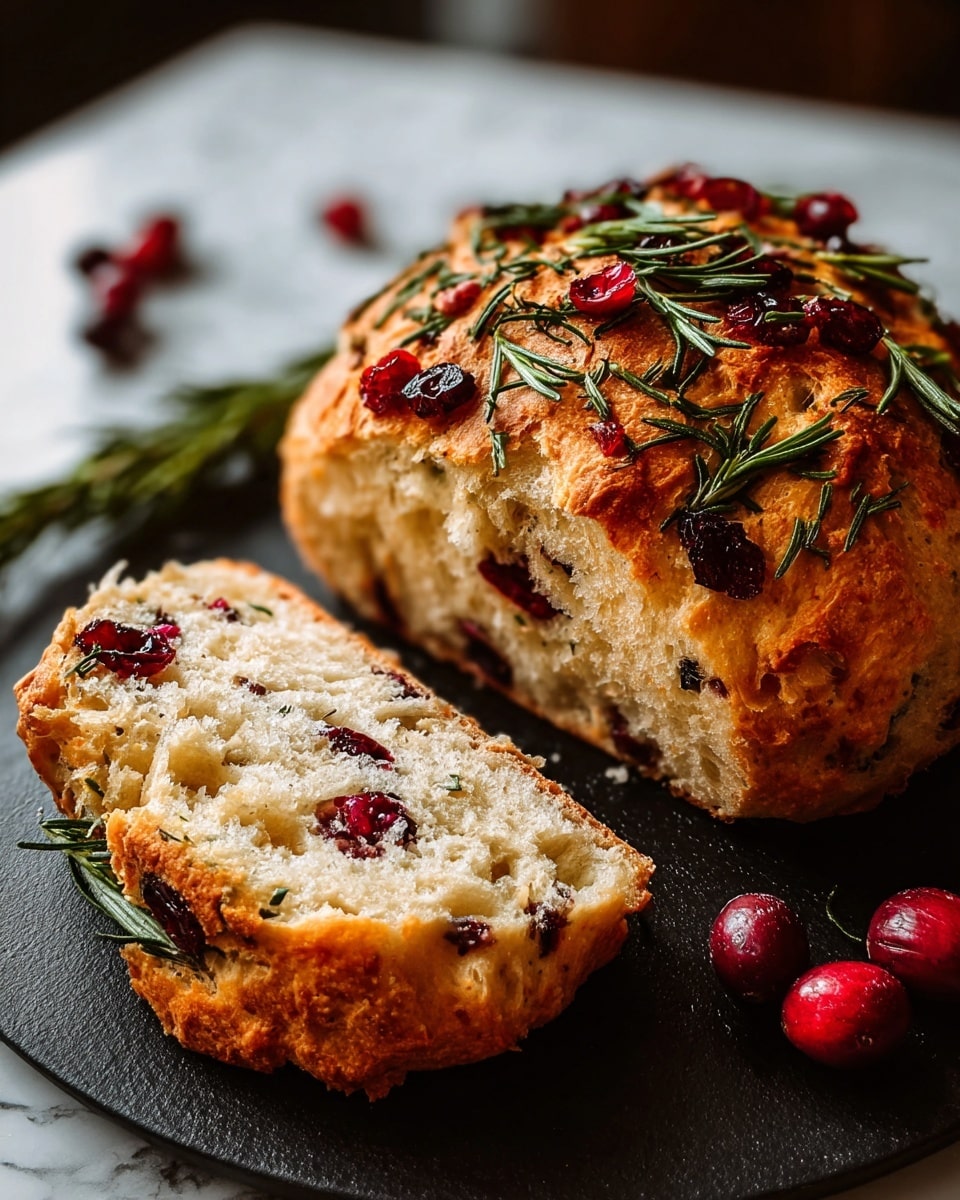I absolutely adore sharing recipes that feel like a warm hug in bread form, and this No-Knead Rosemary Cranberry Bread with Olive Oil & Sea Salt Recipe is just that for me. The perfect balance of tangy cranberries and fragrant rosemary tucked inside a golden crust makes every bite a delightful surprise. What I love most is how easy it is to bring this rustic, cozy loaf to life without any complicated kneading or fancy tools. Whether it’s for a leisurely weekend brunch or a casual gathering, this bread always steals the show and fills my kitchen with irresistible aromas.
Why You'll Love This No-Knead Rosemary Cranberry Bread with Olive Oil & Sea Salt Recipe
From the very first time I baked this bread, I was smitten by the beautiful combination of flavors. The rosemary adds an earthy, piney fragrance that pairs brilliantly with the bursts of sweetness and slight tartness from the dried cranberries. Then, finishing the loaf with a drizzle of rich olive oil and a sprinkle of sea salt elevates it to something truly special, giving a perfect contrast between savory and sweet that dances on your palate.
I also can’t stress enough how effortless this recipe is. If you think baking bread is intimidating, this No-Knead Rosemary Cranberry Bread with Olive Oil & Sea Salt Recipe will change your mind. You just mix, let time do the magic with slow fermentation, and then bake. No exhausting kneading or proofing rituals required. It fits so well into my busy life, and I know it will in yours too.
Another reason this recipe stands out is its versatility. It’s perfect for cozy mornings with a bit of butter or cream cheese, a centerpiece at a holiday meal, or even sliced up for an impromptu snack with a spread of cheeses and olives. This bread genuinely makes any occasion feel a little more special and rustic in the most comforting way.
Ingredients You'll Need

These ingredients are wonderfully simple yet thoughtfully chosen to give you an exquisite loaf. Each one plays a key role in creating the bread’s flavor, texture, and aroma, making the preparation straightforward and rewarding.
TIP : You'll find the full list of ingredients and measurements in the recipe card below
- All-purpose flour: The backbone of the dough, providing structure and chewiness.
- Instant yeast: Ensures a reliable rise without fussing over activation.
- Salt: Enhances all the flavors and controls fermentation.
- Fresh rosemary: Adds that wonderful herbaceous aroma and subtle earthiness—you can substitute dried rosemary if needed.
- Dried cranberries: Bring in a burst of fruity tartness that brightens the bread.
- Warm water: Activates the yeast and hydrates the dough for a soft crumb.
- Olive oil: Contributes richness and keeps the crust tender with a lovely golden color.
- Sea salt: For sprinkling on top, it adds a satisfying crunchy finish and balances sweetness.
Directions
Step 1: In a large mixing bowl, whisk together the all-purpose flour, instant yeast, salt, and chopped fresh rosemary until evenly combined. This ensures the rosemary is distributed well for every bite.
Step 2: Stir in the dried cranberries gently, so they don’t clump together, allowing their sweet tang to spread throughout the dough.
Step 3: Pour in the warm water and olive oil, then stir everything until a sticky, shaggy dough forms with no dry flour remaining. The texture feels loose and slightly wet, which is exactly what you want.
Step 4: Cover the bowl loosely with plastic wrap or a clean towel and let it rest at room temperature for 12 to 18 hours. This slow fermentation is key for developing complex flavors and that wonderful chewy texture.
Step 5: When you’re ready to bake, preheat your oven to 450°F and place a Dutch oven with the lid inside to heat up for at least 30 minutes. This step gives you that perfect hot environment to create a crisp crust.
Step 6: Turn the dough out onto a floured surface and gently shape it into a tight ball without kneading. Transfer it to a piece of parchment paper to make handling easier.
Step 7: Carefully remove the hot Dutch oven from the oven, lift the dough with the parchment paper, and place it inside the pot. Cover with the lid and bake for 30 minutes to trap steam and develop a crust.
Step 8: Remove the lid and bake for an additional 15 minutes uncovered. The bread should turn a gorgeous golden-brown with a slightly blistered crust.
Step 9: Transfer the loaf to a cooling rack. While still warm, drizzle extra olive oil over the top and sprinkle with flaky sea salt for that irresistible finishing touch.
Servings and Timing
This recipe yields one beautiful loaf, perfect for sharing with 6 to 8 people depending on slice thickness. The prep time is just about 15 minutes of actual work, but it requires a long 12 to 18-hour fermentation period at room temperature, so plan ahead. Baking takes approximately 45 minutes total, and I always allow the bread to cool for at least 30 minutes before slicing to let the crumb set properly. Overall, you’re looking at roughly an hour from shaping to finished crust, but the magic really is in the slow soak while you go about your day.
How to Serve This No-Knead Rosemary Cranberry Bread with Olive Oil & Sea Salt Recipe

When it comes to enjoying this No-Knead Rosemary Cranberry Bread with Olive Oil & Sea Salt Recipe, I love to serve it warm or at room temperature to let the flavors shine. It’s delightful simply slathered with softened butter or a creamy cheese spread. The tangy cranberries and aromatic rosemary shine best when the bread is fresh. I also find it pairs beautifully alongside a rich soup or a vibrant salad, making it a standout addition to any autumn or winter meal.
For special occasions, I like arranging the bread on a rustic wooden board, garnished with a sprig of fresh rosemary for a lovely presentation. Drizzling that last bit of good-quality olive oil and a pinch of flaky sea salt just before serving keeps it looking and tasting upscale. Plus, pairing it with a glass of crisp white wine or a light, fruity cocktail really brings out the aromatic notes.
If you’re planning a casual brunch or a cozy night in, this loaf feels just right. It’s impressive enough to serve to guests but easy enough to enjoy on an everyday basis. I recommend slicing it thickly to soak up hearty spreads or thinly for delicate bites with cheese platters. Either way, this bread is a joyous experience that makes any meal feel special.
Variations
One of the wonderful things about this No-Knead Rosemary Cranberry Bread with Olive Oil & Sea Salt Recipe is how adaptable it is. If you want to switch things up, try swapping dried cranberries for dried cherries or golden raisins for a slightly different fruity note. If fresh rosemary isn’t on hand, dried rosemary does the trick nicely, though I always lean towards fresh when I can find it for the best fragrance.
If you have dietary preferences, you can experiment with gluten-free flours, but I recommend using a gluten-free all-purpose blend that includes xanthan gum for structure. The texture will be different, but the flavor remains lovely. For a vegan twist, you can enjoy the bread as-is since it contains no animal products, just check that your olive oil and dried fruits fit your dietary needs.
For cooking methods, this bread is best baked in a Dutch oven to mimic professional steam ovens, but you can also bake it on a preheated baking stone or cast-iron skillet and add a pan of boiling water for steam in the oven. Lastly, try adding other herbs like thyme or oregano for new flavor profiles, or mix in nuts like walnuts for some crunch. I love experimenting with these tweaks while keeping the core technique the same.
Storage and Reheating
Storing Leftovers
After enjoying a few slices fresh, I store leftovers wrapped snugly in a clean kitchen towel or inside a paper bag at room temperature. This helps retain the crust’s texture without trapping moisture. The bread will stay fresh and delicious for about 1 to 2 days this way. Avoid plastic wrap unless you plan to eat it immediately because it tends to soften the crust too much.
Freezing
If I want to keep the bread longer, I slice it first and then place the slices in a freezer-safe bag or container, separating them with parchment paper to prevent sticking. This bread freezes beautifully and can last up to 3 months in the freezer. When you’re ready to enjoy, simply take out the slices you need and either thaw at room temperature or toast directly from frozen.
Reheating
To bring back the fresh-baked magic, I like to reheat slices in a toaster oven or regular oven set around 350°F for about 5 to 10 minutes. This crisps the crust back up nicely while warming the soft crumb inside. Avoid microwaving as it tends to make the crust soggy and chewy. A quick drizzle of olive oil or spreading a bit of butter after reheating really enhances the flavor and texture.
FAQs
Can I use dried rosemary instead of fresh in this bread?
Yes, you absolutely can. Dried rosemary is a convenient substitute and still delivers great aroma. I recommend using about a third of the amount compared to fresh rosemary since dried herbs have a more concentrated flavor. Just make sure to crush the dried rosemary a bit to release its oils before adding it to the dough.
What if I don’t have a Dutch oven—can I still bake this bread?
Definitely! While a Dutch oven creates the best crust by trapping steam, you can bake the bread on a preheated baking stone or heavy baking sheet. To mimic steam, place a pan with hot water on the oven floor during the first 15 minutes of baking. This helps develop a beautiful, crisp crust even without a covered pot.
How long does the dough need to ferment?
For this recipe, I recommend letting the dough ferment at room temperature for 12 to 18 hours. This long, slow rise develops excellent flavor and a chewy texture. If your kitchen is warmer, aim for the shorter end of that range; cooler environments might benefit from the full 18 hours. Just look for the dough to have risen with bubbles and feel puffy.
Can I add other dried fruits or nuts to the bread?
Absolutely! This bread is very versatile. I’ve had great results swapping cranberries for dried cherries, raisins, or even chopped dried apricots. Adding chopped nuts like walnuts or pecans also adds a lovely crunch and depth. Just keep the total add-ins volume similar so it doesn’t affect the dough’s hydration too much.
Is this bread suitable for vegans?
Yes, this No-Knead Rosemary Cranberry Bread with Olive Oil & Sea Salt Recipe is naturally vegan since it contains no eggs, dairy, or animal products. Just double-check the ingredients on your dried cranberries and olive oil to ensure they meet your vegan standards. It’s a fantastic choice if you’re seeking a plant-based homemade bread.
Conclusion
I hope you feel inspired to make this No-Knead Rosemary Cranberry Bread with Olive Oil & Sea Salt Recipe part of your baking repertoire! It’s one of those recipes that rewards your patience with stunning results and fills your home with cozy, inviting scents. Whether you serve it fresh from the oven or share it with friends and family later, it’s a loaf that brings warmth and joy every time. Happy baking—I can’t wait for you to taste the magic!
Print
No-Knead Rosemary Cranberry Bread with Olive Oil & Sea Salt Recipe
- Prep Time: 15 minutes
- Cook Time: 45 minutes
- Total Time: 12 hours 60 minutes
- Yield: 1 loaf
- Category: Bread
- Method: Baking
- Cuisine: American
- Diet: Vegetarian
Description
This No-Knead Rosemary Cranberry Bread with Olive Oil & Sea Salt is a rustic, crusty, and chewy loaf bursting with flavorful dried cranberries and aromatic rosemary. Finished with a golden drizzle of olive oil and a sprinkle of sea salt, this bread is perfect for cozy fall mornings, elegant brunches, or anytime you crave a hearty homemade loaf without the hassle of kneading.
Ingredients
Dry Ingredients
- 3 cups all-purpose flour
- ½ teaspoon instant yeast
- 1 ½ teaspoons salt
- 1 tablespoon fresh rosemary, chopped (or 1 teaspoon dried rosemary)
- ½ cup dried cranberries
Wet Ingredients
- 1 ½ cups warm water
- 2 tablespoons olive oil, plus more for drizzling
Finishing
- Sea salt, for sprinkling
Instructions
- Combine Dry Ingredients: In a large bowl, mix together the flour, instant yeast, salt, and chopped rosemary until evenly distributed.
- Add Cranberries and Wet Ingredients: Stir in the dried cranberries, then pour in the warm water and olive oil. Mix thoroughly until a sticky dough forms.
- Let Dough Rest: Cover the bowl with a lid or plastic wrap and allow the dough to rest at room temperature for 12 to 18 hours to develop flavor and texture through long fermentation.
- Preheat Oven and Dutch Oven: Preheat your oven to 450°F (230°C). Place a Dutch oven with its lid inside the oven to heat for 30 minutes, ensuring it reaches a high temperature for baking.
- Shape Dough: Lightly flour a clean surface and gently turn out the dough. Shape it into a round ball and place it on a piece of parchment paper for easy handling.
- Bake Covered: Carefully remove the hot Dutch oven from the oven. Using the parchment paper, transfer the dough into the Dutch oven. Cover with the lid and bake for 30 minutes to trap steam for a crispy crust.
- Bake Uncovered: Remove the lid and continue baking the bread for an additional 15 minutes until the crust turns golden brown and crisp.
- Cool and Finish: Transfer the bread to a wire rack to cool. Once cooled slightly, drizzle with olive oil and sprinkle with sea salt before slicing and serving.
Notes
- The long fermentation time enhances the bread's flavor and texture, so don’t skip this step.
- Use a kitchen scale for accurate flour measurements, especially for best results.
- Fresh rosemary provides the most fragrant aroma, but dried rosemary is a suitable alternative.
- You can substitute dried cranberries with dried cherries or golden raisins for a different twist.
- Store the bread wrapped in a towel at room temperature for 1 to 2 days to maintain freshness.






Leave a Reply